The Hydrogeochemical Characteristics and Formation Mechanisms of the High-Salinity Groundwater in Yuheng Mining Area of the Jurassic Coalfield, Northern Shaanxi, China
Abstract
1. Introduction
2. Hydrogeological Setting
3. Sample Collection and Analytical Testing
4. Analytical Test Results
5. Discussion
5.1. Typical Characteristic Ion Distribution
5.2. Combination Characteristics of Hydrochemical Parameters
5.3. Hydrogen and Oxygen Isotope Characteristics
5.4. Age of High Mineralization Water Age
5.5. Primitive Sedimentary Environment
5.6. Analysis of Rock Salt Minerals in Coal Rock Interlayers
5.7. Formation Mechanism of High-Salinity Water
6. Conclusions
- (1)
- The mineralization degree (TDS) of the groundwater in the Yuheng mining area of northern Shaanxi increases from the Quaternary to Jurassic strata (1.23–36.20 g/L, with an average of 9.39 g/L), and the hydrochemical type gradually changes from HCO3-Ca type to SO4-Na type. The low sodium–calcium ratio and unsaturated salt mineral characteristics indicate that its hydrogeochemical evolution is in the immature to semi mature stage.
- (2)
- The highly mineralized groundwater in the Jurassic strata of the Yuheng mining area mainly exists in the Yan’an Formation, which is brackish water, saline water, and even saline water, gradually decreasing upwards. Some parts of the Zhiluo Formation and the Anding Formation area exhibit characteristics of brackish water. On the plane, the overall southwestern region is higher than the northeastern region, with the highest mineralization in the Hengshan-Boluo mining field and Weiqiang coal mining area in the central region. The Wusuhaize exploration area, Hongshiqiao-Weijiamao exploration area in the northwest, the Hongdunjie and Haizetan mining fields in the southwest have secondary high-value centers.
- (3)
- The highly mineralized water in the Yan’an Formation of the Yuheng Mining Area in northern Shaanxi comes from atmospheric precipitation, which is a mixture of sub modern water and recent water. The highly mineralized water is formed by the infiltration of atmospheric precipitation into the Jurassic strata and the leaching of sedimentary rock salt. Due to the strong sealing of the strata and the location in arid areas with insufficient recharge, the groundwater circulation alternates slowly, showing the characteristics of high mineralization. The distribution of water mineralization is controlled by the structure and primary sedimentation.
Author Contributions
Funding
Data Availability Statement
Conflicts of Interest
References
- Dang, X.; Zhang, M.; Dong, Y. Research on protection and exploitation of groundwater resources in Northern Shaanxi Jurassic Coalfield. Front. Geol. 2010, 17, 200–207. [Google Scholar]
- Zhang, D.; Li, W.; Lai, X.; Fan, G.-W.; Liu, W.-Q. Development on basic theory of water protection during coal mining in northwest of China. China Coal Soc. 2017, 042, 36–43. [Google Scholar]
- Sun, K.; Fan, L.; Xia, Y.; Li, C.; Chen, J.; Wu, B.; Peng, J. Research on carrying capacity of geological environment based on the concept of water-preserved coal mining. J. China Coal Soc. 2019, 44, 830–839. [Google Scholar]
- Deng, N.; Yang, P.; Lin, P.; Li, F.; Lei, S.; Ma, F.; Zhou, Y.; Yuan, X. Study on zone chart of engineering geological conditions of protected water resources during coal mining in Yushen Mining Area. Coal Sci. Technol. 2017, 9, 167–174. [Google Scholar]
- Jin, D.; Wang, T.; Zhao, B.; Li, D.; Zhou, Z.; Shang, H. Distribution characteristics and formation mechanism of high salinity groundwater in northeast Ningdong Coalfield. Coal Geol. Explor. 2022, 50, 118–127. [Google Scholar]
- Ma, X.; Cheng, Z.; Cui, J.; Han, J.; Yin, C. Risk assessment of roof water inrush in No. 8 coal seam of Jurassic system Yan’an Formation in the first mining area of Xinzhuang Coal Mine in Ningzheng Mining Area. Coal Sci. Technol. 2023, 51 (Suppl. S1), 298–309. [Google Scholar]
- Dong, S.; Wang, H.; Huang, X.; Wang, H.; Cao, H.; Wang, X.; Zhang, Y.; Miao, H. Research on active water conservation technology in open-pit coal mine based on ecological protection groundwater level. Coal Sci. Technol. 2021, 49, 49–57. [Google Scholar]
- Sun, W.; Li, W.; Ning, D.; Ren, L. Current states, prediction and prevention suggestions for water hazard accidents in China’s coal mines. Coal Geol. Explor. 2023, 51, 185−194. [Google Scholar]
- Jin, D.; Liu, Q.; Wang, L.; Ding, X. Development and prospect of coal deposit hydrogeology. Coal Geol. Explor. 2009, 37, 28–31,36. [Google Scholar]
- Li, W.; Sun, H. Variation characteristics and cause of mine water quality in Malan coal mine. Coal Geol. Explor. 2013, 41, 46–49. [Google Scholar]
- Xiao, C. Hydrogeology; Geological Publishing House: Bath, UK, 2010. [Google Scholar]
- Ning, C.; Xing, M. Research on the law of watering and risk of Confined water-inrush From I5 Coal seam floor. Sci. Technol. Inf. 2012, 23, 400–401. [Google Scholar]
- Wu, J.; Wu, M.; Shen, J. Hydraulic Characteristics of limestone aquifer in Ji group coal floor and its impact to coal mine water filling in NO.12 Mine of Pingdingshan Coal mining group corporation. Zhongzhou Coal 2009, 10, 23–25. [Google Scholar]
- Hou, E.; Tong, R.; Wang, S.; Feng, J.; Chen, T. Prediction method for the water enrichment of weathered bedrock based on Fisher model in Northem Shaaxi Jurassic coal field. J. China Coal Soc. 2016, 41, 2312–2318. [Google Scholar]
- Zhao, C.; Jin, D.; Li, Z.; Shen, X.; Wang, H.; Wang, S.; Xu, F.; Wang, Q. Analysis of overlying aquifer water inrush above mining seam in Yushen mining area. J. China Coal Soc. 2021, 46, 523–533. [Google Scholar]
- Tarasenko, I.; Kholodov, A.; Zinkov, A.; Chekryzhov, I. Chemical composition of groundwater in abandoned coal mines: Evidence of hydrogeochemical evolution. Appl. Geochem. 2022, 137, 105210. [Google Scholar] [CrossRef]
- Fang, G.; Yang, J. Research on hydrogeochemical characteristics in Balasu well field of Yuheng mining area. Saf. Coal Mines 2019, 50, 56–62. [Google Scholar]
- Wang, S. Hydrogeochemical characteristics and forming reason of Ordovician limestone groundwater in Zhuoshan Coalfield. Coal Sci. Technol. 2022, 50, 180–188. [Google Scholar]
- Fan, L.; Ma, W.; Chang, B.; Sun, K.; Miao, Y.; Lu, B.; Tian, S.; Yang, L. Hydrochemical characteristics and formation mechanism of groundwater in Yushenfu Mining Area. Coal Sci. Technol. 2023, 51, 383–394. [Google Scholar]
- Li, W.; Gao, C.; Zhang, T.; Zhang, X. Analysis of hydrogeological characteristics and water filling conditions of Xiaojihan mine field in Yuheng mining area, northern Shaanxi. Geol. Shaanxi 2014, 32, 84–90. [Google Scholar]
- Ma, Z.; Li, J.; Zhai, M.; Wu, M.; Xu, Y. A comparative study of isotopic hydrogeochemistry of geothermal fluids of sedimentary basin type and volcanic type. Hydrogeol. Eng. Geol. 2019, 46, 9–18. [Google Scholar]
- Li, T.; Tan, H.; Fan, Q. Hydrochemical Characteristics and Origin Analysis of the Underground Brines in West Qaidam Basin. J. Salt Lake Res. 2006, 14, 26–32. [Google Scholar]
- Sun, H.; Wang, G.; Lin, W. Distribution characteristics and enrichment mechanism of TDS geothermal water in Xining Basin. Bull. Geol. Sci. Technol. 2022, 41, 278–287. [Google Scholar]
- Zhang, C.; Hou, X.; Li, X.; Wang, Z.; Gui, C.; Zuo, X. Hydrogeochemical characteristics and evolution mechanism of karst groundwater in the catchment area of the Sangu Spring. Hydrogeol. Eng. Geol. 2021, 48, 62–71. [Google Scholar]
- Cai, C.; Mei, B.; Li, W. Fliud migration and alteration: Constraints chemistry of Palaeozoic oil field water in central Tarim. Pet. Explor. Dev. 1997, 24, 18–22. [Google Scholar]
- Li, J.; Li, T.; Peng, X.; Han, Y.; Li, Z.; Ma, H. Hydrogeochemical behaviors of oil field water in the Tertiary in western Qaidarn Basin. Oil Gas Geol. 2014, 35, 50–55. [Google Scholar]
- Gibbs, R.J. Mechanisms controlling world water chemistry. Science 1970, 170, 1088–1091. [Google Scholar] [CrossRef]
- Gaillardet, J.; Dupré, B.; Louvat, P.; Allegre, C.J. Global silicate weathering and CO2 consumption rates deduced from the chemistry of large rivers. Chem. Geol. 1999, 159, 3–31. [Google Scholar] [CrossRef]
- Cllark, I.C.; Peter, F. Environmental Isotopes in Hydrogeology; Lewis Publishers: New York, NY, USA, 1997. [Google Scholar]
- Wang, S.; Zhang, Y. The formation and evolution of Ordos Basin and the law of coal accumulation. Front. Geol. 1999, 6, 147–155. [Google Scholar]
- Wang, D.; Shao, L.; Li, Z. Palaeogeographic characteristics of the Middle Jurassic Yan an Age in northern Shaanxi Province. J. Palaeogeogr. 2012, 14, 451–460. [Google Scholar]
- Wang, H.; Ma, L. Study on sediment environment and rock mechanics characteristics of the delta plain of Jurassic coalfield in northern Shaanxi. Coal Geol. Explor. 2019, 47, 61–69. [Google Scholar]
- Ma, L. Study on distribution characteristics and sedimentary genesis of sulfur in coal taking southern Yuheng Mining Area of Ordos Basin as a case. Coal Sci. Technol. 2020, 48, 200–209. [Google Scholar]

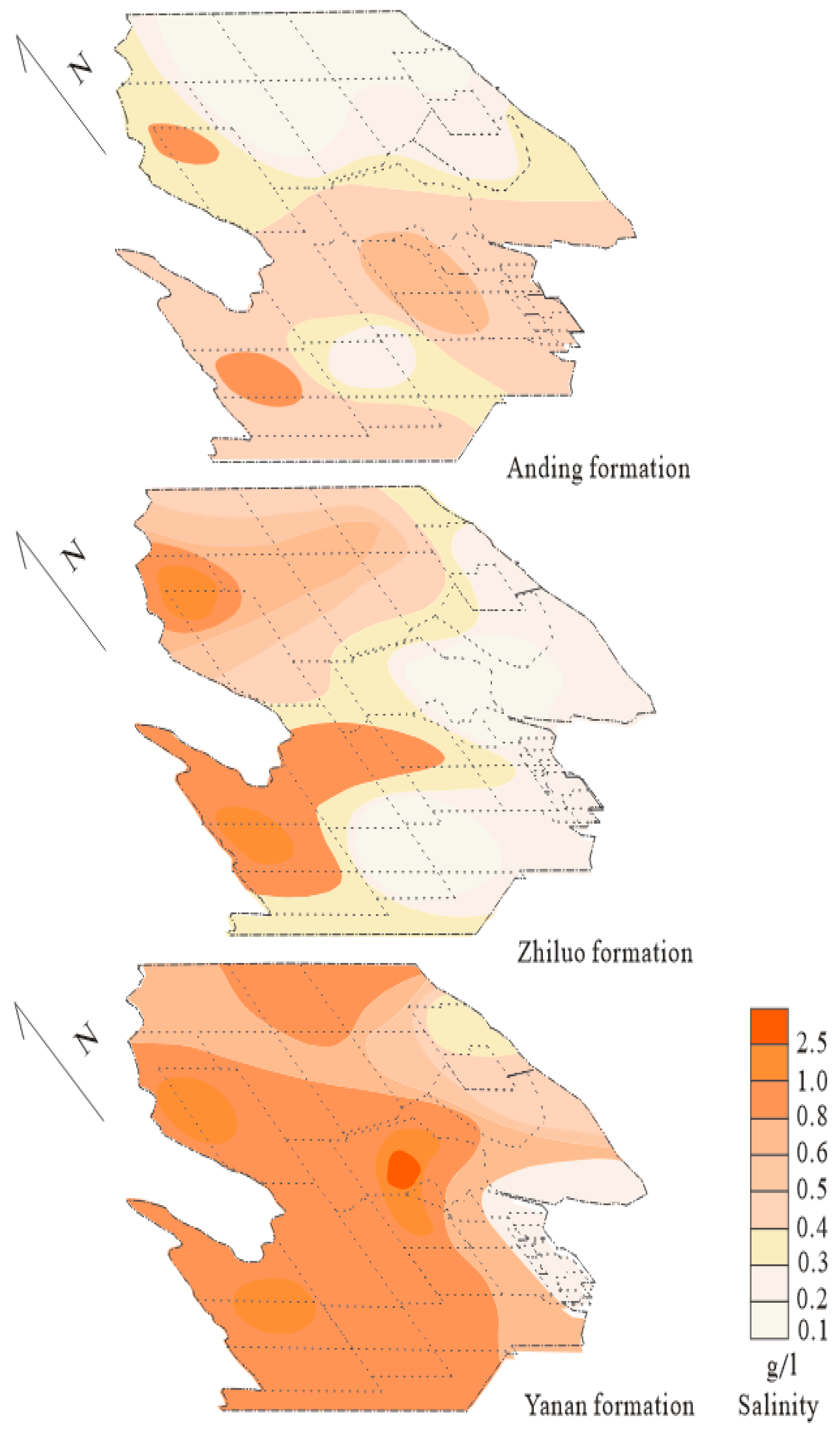
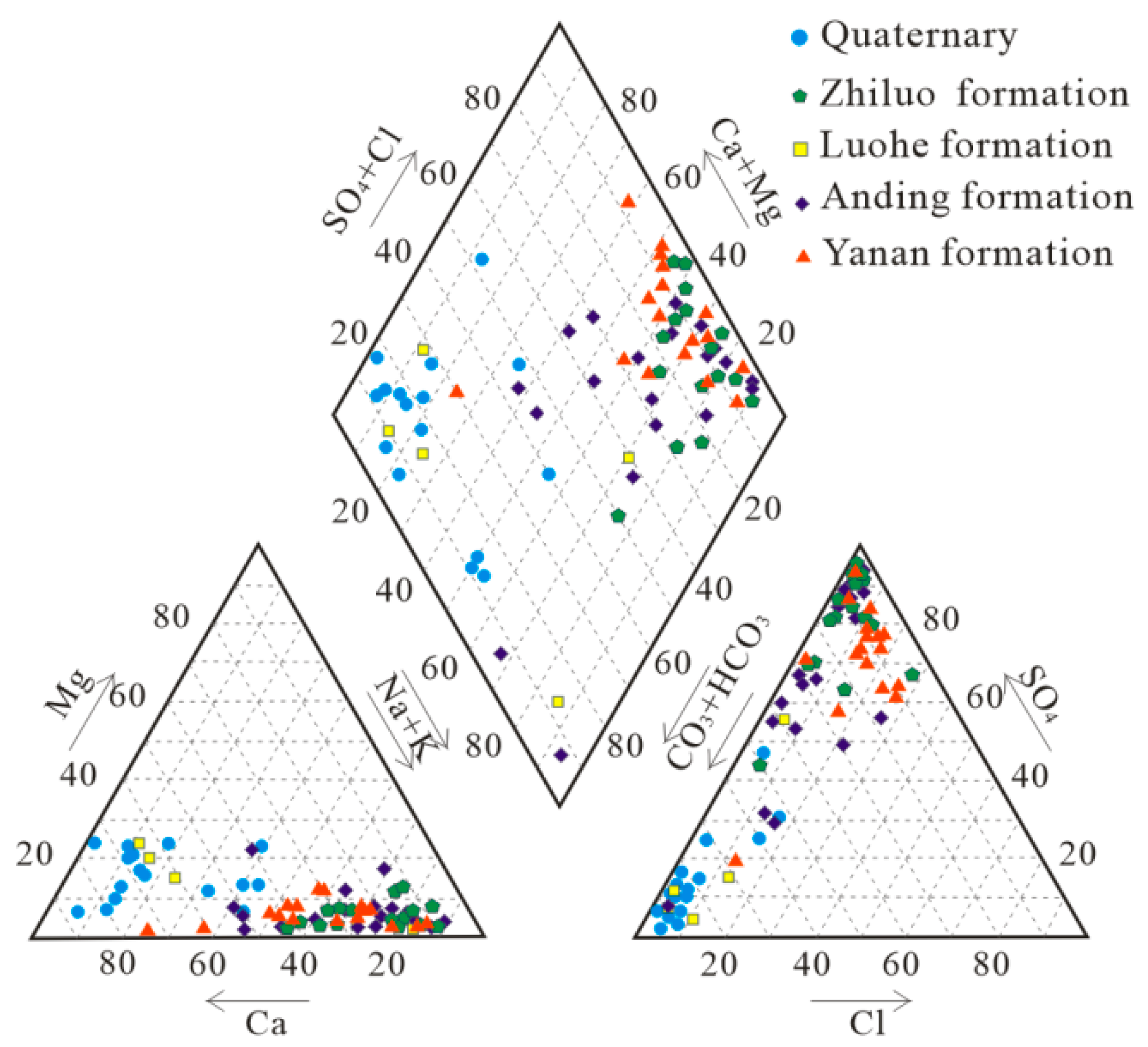
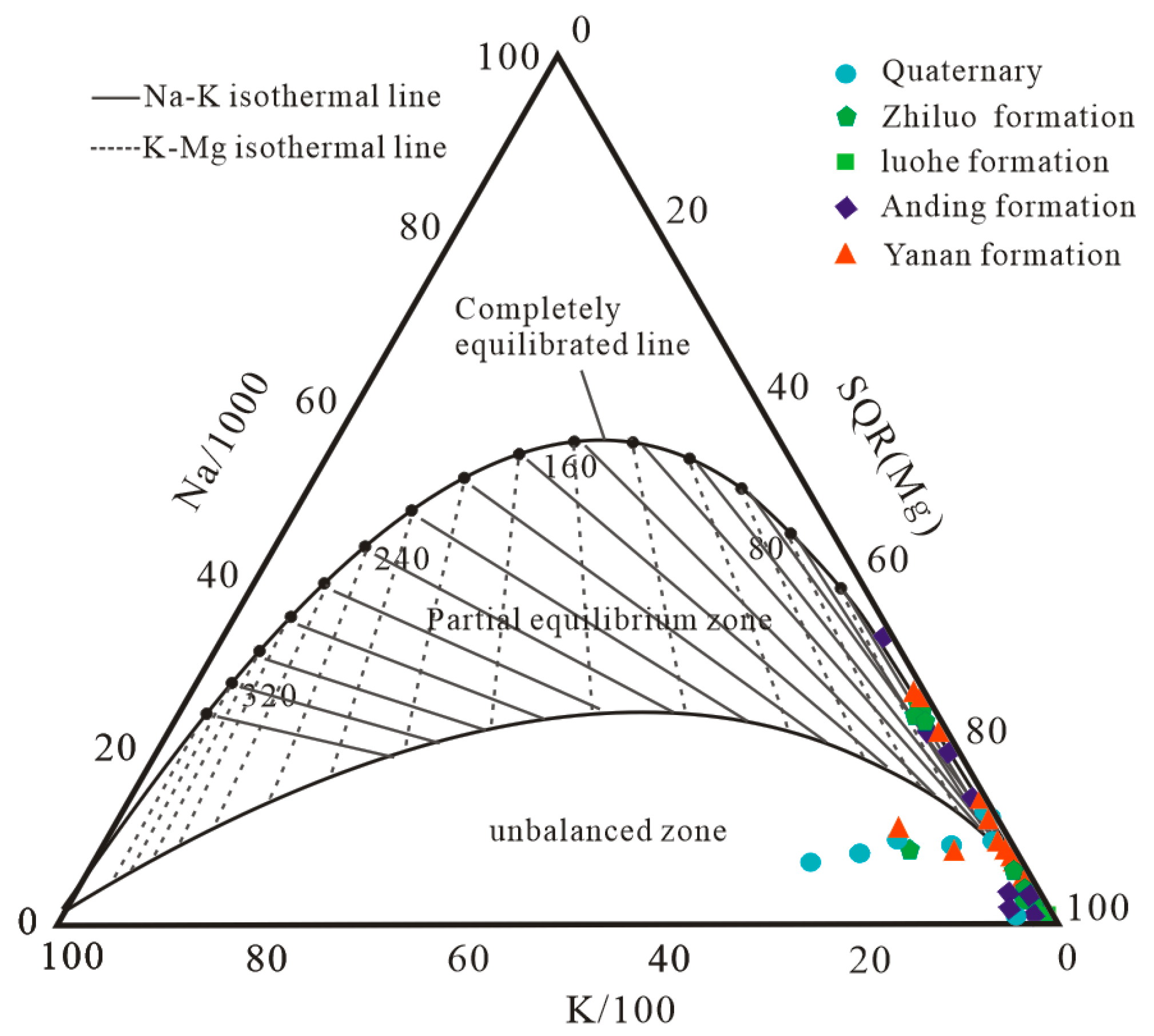


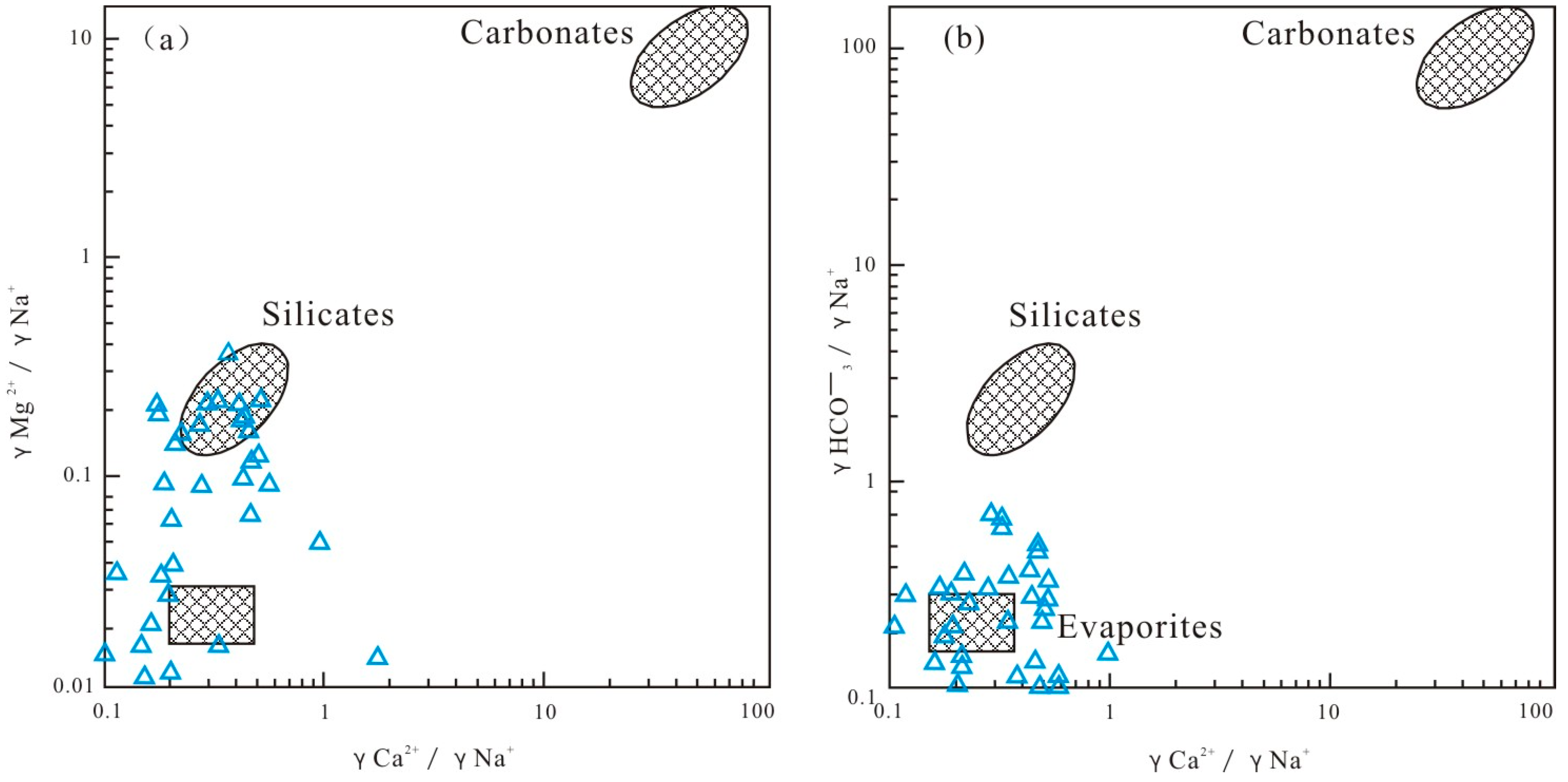
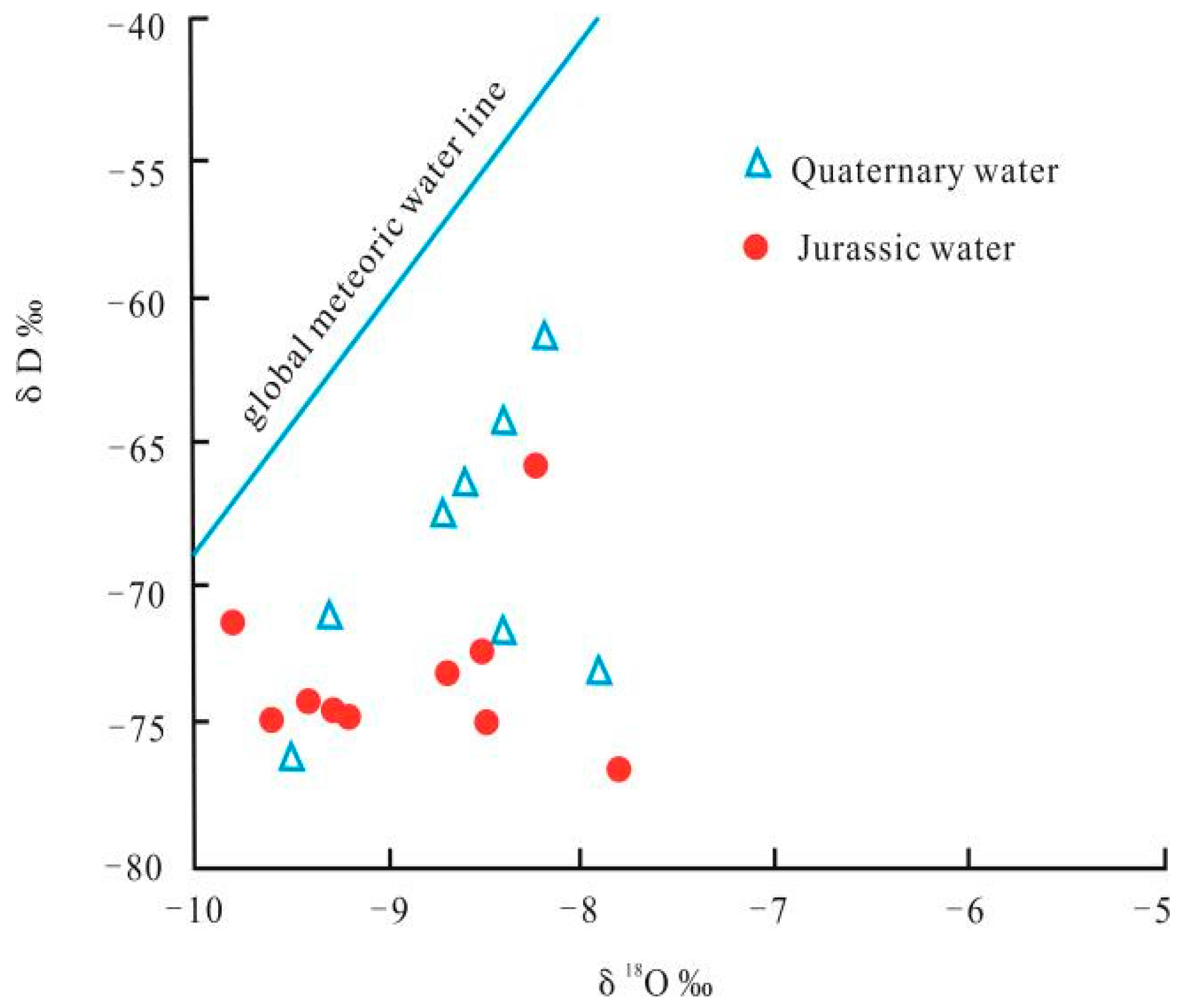

| Stratigraphic System | Thickness /m | Lithology | Groundwater Type | Aquifer Group | Distribution Area | |||
|---|---|---|---|---|---|---|---|---|
| Boundary | Line | Series | Set | |||||
| Neozoic | Quaternary | Q4 | 0~30 | Alluvial sand gravel layer and aeolian sandy land | Loose rocks pores fissure diving | Valley alluvium diving | River Valley Terrace Area | |
| Q3 | Malan | 0~50 | Loose silty clay | Pore diving in alluvial lacustrine deposits | Desert beach area | |||
| Sarawusu | 0~107 | Silty sandy loam, sub-clay | ||||||
| Q2 | Liushi | 0~220 | Sandy clay thin sub-clay | Loess fissure pore diving | Huangtuliangmao District | |||
| Q1 | Wucheng | 0~36 | Silty clay containing calcareous concretion | / | Poor water richness | / | ||
| Neoproterozoic | N2 | Jingle | 0~100 | Layered sandy clay, with calcareous concretion layer | / | Poor water richness | / | |
| Mesozoic | Cretaceous | K1 | Luohe | 0~340 | Coarse grained sandstone, glutenite | Debris rocks fissure pores diving and layer | Sandstone fissure, pore diving | Generally distributive |
| Jurassic | J2 | Anding | 0~170 | Sandy mudstone, fine sandstone, local coarse conglomerate | Fissure diving in bedrock weathering zone | Fissure diving is developed in bedrock weathering zone, confined water is widely distributed below the weathering zone, and fissure diving is developed in burnt rock area | ||
| Zhiluo | 0~250 | Coarse or medium coarse sandstone, fine sandstone, siltstone, silty mudstone | Interlayer confined water | |||||
| Yan’an | 103~395 | Coarse grained sandstone, fine sandstone, siltstone, silty mudstone, mudstone, carbonaceous mudstone, coal seam | Interlayer confined water; burnt rock fissure diving | |||||
| J1 | Fu county | 0~130 | Medium-thick sandstone, sandy mudstone, black thin carbonaceous mudstone | Interlayer confined water | ||||
| Triassic | T3 | Wayaobao | 0~450 | Sandstone, siltstone, mudstone, mudstone with coal line | Interlayer confined water; burnt rock fissure diving | |||
| Coal Mine or Mine Field | Aquifer formation | Sample Size | Mineralization g/L | Coal Mine or Mine Field | Aquifer formation | Sample size | Mineralization g/L |
|---|---|---|---|---|---|---|---|
| Dahaize | Quaternary | 1 | 0.26 | Yuandatan | Quaternary | 3 | 0.23~0.66 |
| Luohe | 1 | 0.39 | Luohe | 1 | 0.65 | ||
| Anding | 1 | 0.83 | Anding | 2 | 0.97~1.49 | ||
| Zhiluo | 1 | 5.13 | Zhiluo | 2 | 2.47~4.21 | ||
| Yan’an | 3 | 4.97~5.27 | Yan’an | 4 | 3.82~5.72 | ||
| Balasu | Quaternary | 1 | 0.27 | Wusuhaize | Quaternary | 2 | 0.33~0.46 |
| Luohe | 1 | 0.35 | Luohe | 2 | 0.37~0.74 | ||
| Anding | 2 | 0.47~0.50 | Anding | 1 | 9.12 | ||
| Zhiluo | 1 | 4.58 | Zhiluo | 2 | 5.13~10.30 | ||
| Yan’an | 2 | 4.24~6.15 | Yan’an | 2 | 5.840~10.97 | ||
| Hongshixia | Quaternary | 2 | 0.25~317.00 | Huanghaojie | Quaternary | 1 | 0.23 |
| Anding | 1 | 0.370 | Anding | 1 | 0.38 | ||
| Zhiluo | 1 | 1.28 | Zhiluo | 1 | 0.78 | ||
| Yan’an | 2 | 3.59~3.70 | Yan’an | 3 | 6.42~9.58 | ||
| Xiaojihan | Quaternary | 1 | 0.22 | Hengshan- Boluo | Quaternary | 1 | 0.33 |
| Luohe | 1 | 0.32 | Anding | 1 | 0.55 | ||
| Anding | 1 | 0.48 | Zhiluo | 2 | 0.55~0.70 | ||
| Yan’an | 2 | 7.68~9.48 | Yan’an | 2 | 6.35~36.25 | ||
| Zhaoshipan | Quaternary | 1 | 0.22 | Shiliutai | Quaternary | 3 | 0.17~0.25 |
| Anding | 2 | 2.36~2.93 | Anding | 2 | 0.86~1.49 | ||
| Zhiluo | 1 | 0.52 | Zhiluo | 1 | 0.47 | ||
| Yan’an | 1 | 9.10 | Yan’an | 1 | 4.56 | ||
| Haizetan | Anding | 1 | 9.38 | Luhe | Anding | 1 | 5.84 |
| Zhiluo | 1 | 10.36 | Zhiluo | 1 | 5.97 | ||
| Yan’an | 2 | 7.41~10.85 | Yan’an | 3 | 4.76~9.99 | ||
| Leilongwan | Anding | 2 | 2.69~4.67 | Tawan | Anding | 2 | 2.68~3.20 |
| Zhiluo | 1 | 7.62 | Zhiluo | 1 | 0.33 | ||
| Yan’an | 2 | 3.63~8.88 | Yan’an | 2 | 5.32~9.55 | ||
| Hongshiqiao -Weijiamao | Anding | 2 | 2.63~9.13 | Weiqiang | Anding | 2 | 1.25~5.84 |
| Zhiluo | 2 | 3.11~4.06 | Zhiluo | 3 | 4.67~8.69 | ||
| Yan’an | 2 | 6.48~8.97 | Yan’an | 4 | 4.87~10.53 | ||
| Fanjiahe | Quaternary | 1 | 0.14 | Kekegai | Zhiluo | 1 | 6.83 |
| Zhiluo | 1 | 0.97 | |||||
| Yan’an | 2 | 1.04~1.23 |
| Age Experience Division | Tritium Value in Target Area | |||||
|---|---|---|---|---|---|---|
| Tritium Test Range | Age Domain | Mine Fields/Coal Mines | Layer | Sample Size | Tritium Test Range | Data Sources |
| <0.8 TU | Sub-Modern Water, recharged before 1652 | Yuandatan | Quaternary System | 2 | 17.8~26.2 TU | Tests in this article |
| Yan’an Formation | 3 | 1.7~5.7 TU | ||||
| 0.8 TU~4 TU | Sub-modern water and recently supplied mixed water | Weiqiang | Luohe Formation | 2 | 25.2~26.1 TU | |
| Yan’an Formation | 5 | 2.1~15.6 TU | ||||
| 5~15 TU | Modern water (<5~10 years ) | Xiaojihan | Quaternary System | 3 | 17.1~27.2 TU | |
| 15~30 TU | Groundwater containing some nuclear explosion tritium | Yan’an Formation | 3 | 3.8~5.3 TU | ||
| >30 TU | Containing a considerable amount of the water supply from the 1960s or the water supply from the 1970s | Balasu | Quaternary System | / | 11.6~27.9 TU | Dr. Fang Gang [17] |
| Luohe Formation | / | 1.0~1.9 TU | ||||
| >50 TU | Mainly the water supply from the 1960s | Yan’an Formation | / | 1.0~2.1 TU | ||
| Sample Number | Mineral Composition/% | ||||
|---|---|---|---|---|---|
| Gypsum | Clay Mineral | Siderite | Pyrite | Anhydrite | |
| YDT-01 | 80.8 | 6 | 6.5 | 5.6 | 1.1 |
| YDT-02 | 87.6 | 3.8 | 4.7 | 3.9 | 0 |
| YDT-03 | 86.4 | 0.3 | 3.5 | 6.7 | 3.1 |
| WQ-01 | 85.7 | 5.3 | 4.7 | 3.5 | 0.8 |
| WQ-02 | 86.3 | 4.1 | 3.2 | 6.4 | 0 |
| average value | 85.4 | 3.9 | 4.5 | 5.2 | 1 |
Disclaimer/Publisher’s Note: The statements, opinions and data contained in all publications are solely those of the individual author(s) and contributor(s) and not of MDPI and/or the editor(s). MDPI and/or the editor(s) disclaim responsibility for any injury to people or property resulting from any ideas, methods, instructions or products referred to in the content. |
© 2025 by the authors. Licensee MDPI, Basel, Switzerland. This article is an open access article distributed under the terms and conditions of the Creative Commons Attribution (CC BY) license (https://creativecommons.org/licenses/by/4.0/).
Share and Cite
Han, Y.; Zhao, H.; Ji, Y.; Wang, Y.; Zhang, L. The Hydrogeochemical Characteristics and Formation Mechanisms of the High-Salinity Groundwater in Yuheng Mining Area of the Jurassic Coalfield, Northern Shaanxi, China. Water 2025, 17, 1459. https://doi.org/10.3390/w17101459
Han Y, Zhao H, Ji Y, Wang Y, Zhang L. The Hydrogeochemical Characteristics and Formation Mechanisms of the High-Salinity Groundwater in Yuheng Mining Area of the Jurassic Coalfield, Northern Shaanxi, China. Water. 2025; 17(10):1459. https://doi.org/10.3390/w17101459
Chicago/Turabian StyleHan, Yuanhong, Hongchao Zhao, Yongtao Ji, Yue Wang, and Liwei Zhang. 2025. "The Hydrogeochemical Characteristics and Formation Mechanisms of the High-Salinity Groundwater in Yuheng Mining Area of the Jurassic Coalfield, Northern Shaanxi, China" Water 17, no. 10: 1459. https://doi.org/10.3390/w17101459
APA StyleHan, Y., Zhao, H., Ji, Y., Wang, Y., & Zhang, L. (2025). The Hydrogeochemical Characteristics and Formation Mechanisms of the High-Salinity Groundwater in Yuheng Mining Area of the Jurassic Coalfield, Northern Shaanxi, China. Water, 17(10), 1459. https://doi.org/10.3390/w17101459






